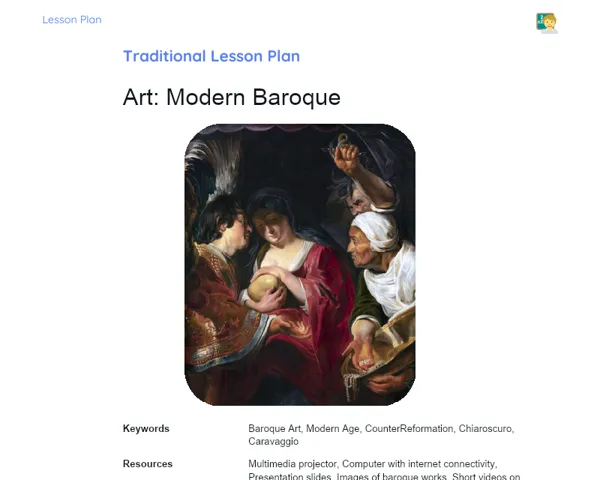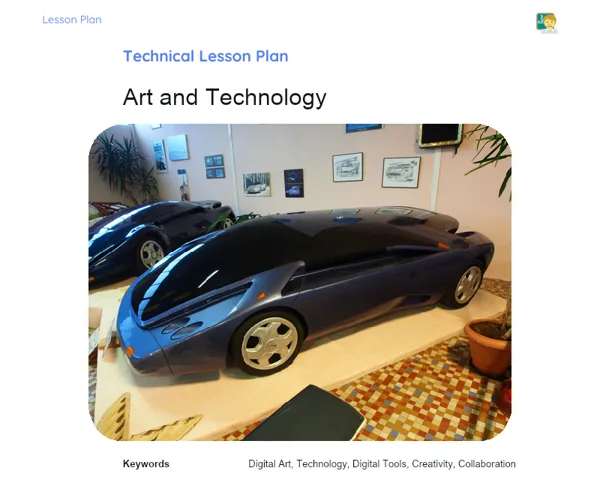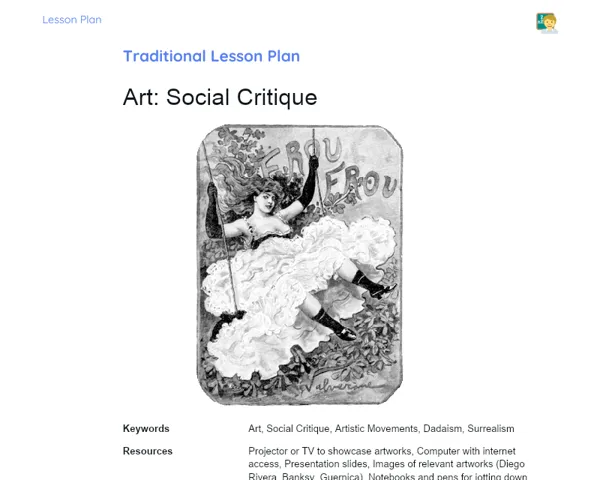Lesson Plan | Lesson Plan Tradisional | Art: Social Critique
| Keywords | Art, Social Critique, Artistic Movements, Dadaism, Surrealism, Graffiti, Diego Rivera, Banksy, Guernica, Pablo Picasso, Social Change, History of Art, Contemporary Art, Resistance, Transformation |
| Resources | Projector or TV to showcase artworks, Computer with internet access, Presentation slides, Images of relevant artworks (Diego Rivera, Banksy, Guernica), Notebooks and pens for jotting down notes, Whiteboard and markers, Texts or articles relating to artistic movements and social critique, Examples of contemporary artworks |
Objectives
Duration: (10 - 15 minutes)
This stage aims to introduce learners to the concept of art as a tool for social critique and to highlight the significance of social movements in the evolution of art. By providing a clear overview, students will be better equipped to understand and analyse specific instances of how art intersects with social and political dilemmas.
Objectives Utama:
1. Explain how art can be a powerful vehicle for social critique.
2. Illustrate examples of social movements that have harnessed art to drive change.
3. Demonstrate how different art forms can express social and political messages.
Introduction
Duration: (10 - 15 minutes)
This section aims to introduce students to the notion of art as a vehicle for social critique and to establish the importance of social movements in the history of art. By providing a solid overview, students will be better positioned to dissect specific examples of the relationship between art and social-political issues.
Did you know?
Did you know that graffiti, as a form of urban art, originated as a protest method in New York during the 1970s? Young creators took to the city walls to voice their frustrations regarding social inequality and police violence. These days, graffiti is acknowledged worldwide as a legitimate form of art and continues to function as a platform for social critique.
Contextualization
Art has always served as a potent means of expression—of emotions, ideas, and notably, social critiques. From Diego Rivera’s striking murals in Mexico to Banksy’s thought-provoking street pieces in London, art has historically given voice to the voiceless and stirred societal change. Throughout the 20th and 21st centuries, numerous artistic movements have surfaced in response to socio-political challenges, employing art as a medium for both resistance and transformation.
Concepts
Duration: (40 - 50 minutes)
This stage seeks to deepen students' understanding of art as a tool for social critique. By examining specific examples and analysing historical movements, students will be equipped to identify and discuss how art intersects with social issues. The proposed questions encourage learners to apply what they've learned and reflect on art's current role in society.
Relevant Topics
1. Introduction to Social Critique in Art: Introduce that art has been historically used as a strong medium for relaying social critiques. Reference well-known artists like Diego Rivera and Banksy, highlighting how their work reflects societal and political concerns.
2. Artistic and Social Movements: Elaborate on how movements like Dadaism, Surrealism, and Graffiti arose in reaction to particular social and political environments. Emphasise that these movements leveraged art to challenge and question societal norms.
3. Examples of Art and Social Critique: Present particular works that embody social critiques in art. Include pieces like 'Guernica' by Pablo Picasso, which critiques violence and warfare, and Rivera’s murals that address themes of social injustice and labour rights.
4. Impact and Legacy: Discuss the societal impact these works and movements have had. Illustrate how art can sway public sentiment, provoke critical thought, and even incite social change.
To Reinforce Learning
1. Identify a contemporary artwork that you think represents a form of social critique. Explain your choice and discuss the potential impact this work may have on society.
2. Compare the aims and techniques of two artistic movements that utilised art for social critique. What were the main similarities and differences between them?
3. How do you envision art being used to tackle current social and political issues? Provide specific examples and discuss how these instances can influence society.
Feedback
Duration: (20 - 25 minutes)
This stage aims to solidify students' learning via reflection and discussion of the questions posed in the Development phase. Engaging in this in-depth discussion helps cement acquired knowledge, promotes critical thinking, and encourages meaningful dialogue about art's role in social critique.
Diskusi Concepts
1. Discussion of Questions:
-
Identify a contemporary artwork that you believe represents a form of social critique. Explain your choice and discuss the impact that this work can have on society. Stress that the choice of artwork ought to focus on how it addresses specific social and political issues. Discussion should encompass analysis of the context in which the artwork was created, its intended message, and its reception by the public. You might consider works by contemporary artists like Ai Weiwei, who uses art to call out issues of censorship and human rights violations in China.
-
Compare the objectives and methods of two artistic movements that employed art for social critique. What were the key differences and similarities between them? Clarify that the comparison should investigate factors like historical context, artistic methods employed, and the themes they addressed. For instance, contrast Dadaism, which surfaced as a reaction to World War I’s horrors and used art to challenge logic, with Graffiti, which emerged as a form of urban protest against social inequities and police misconduct.
-
How do you think art can be employed to address current social and political issues? Provide specific examples and discuss how these cases can impact society. Emphasise that contemporary art remains a vigorous medium for social critique. Encourage students to explore present-day instances like digital art and installations addressing issues such as the climate crisis, gender equality, and LGBTQ+ rights. Delve into how these works can elevate societal awareness, foster dialogue, and motivate action for change.
Engaging Students
1. Questions and Reflections to Engage Students:
- What do you think inspires an artist to use their work as a form of social critique?
- In what ways does street art, like graffiti, differ from other art forms concerning accessibility and societal impact?
- Do you believe that art can effectively spur social change? Why or why not?
- What obstacles do artists confront when producing works of social critique?
- How does social media shape the spread and effect of social critique art today?
- Consider a social issue that is important to you. How would you depict that issue through art?
- In what ways does censorship impact the creation of critical art in various parts of the world?
- How can art be incorporated into social and political awareness campaigns?
Conclusion
Duration: (10 - 15 minutes)
This stage's aim is to summarise and reinforce the core points addressed during the lesson, ensuring students grasp the importance of art as a medium for social critique. This concluding review helps cement acquired knowledge and underscores the practical relevance of the concepts discussed.
Summary
['Art has historically been a robust medium for conveying social critiques.', 'Artistic movements such as Dadaism, Surrealism, and Graffiti developed in response to specific social and political contexts.', "Works like Picasso's 'Guernica' and Rivera's murals serve as prime examples of social critique in art.", 'Art has the power to shape public opinion, provoke contemplation, and inspire social and political change.']
Connection
The lesson effectively married theory with practice, presenting historical and contemporary examples of how various art forms have been and continue to be used to tackle social and political matters. Students experienced firsthand how artistic movements and particular works have served as sources of resistance and social transformation, illustrating the synergy between art and social critique in the real world.
Theme Relevance
The topic strikes a chord with students' everyday lives, as art remains a formidable means of expression and critique. Understanding art's capacity to influence society empowers students to see artists as catalysts for social change. Additionally, by analysing artworks and movements, students cultivate critical thinking abilities and appreciate the significance of art within social and political frameworks.



